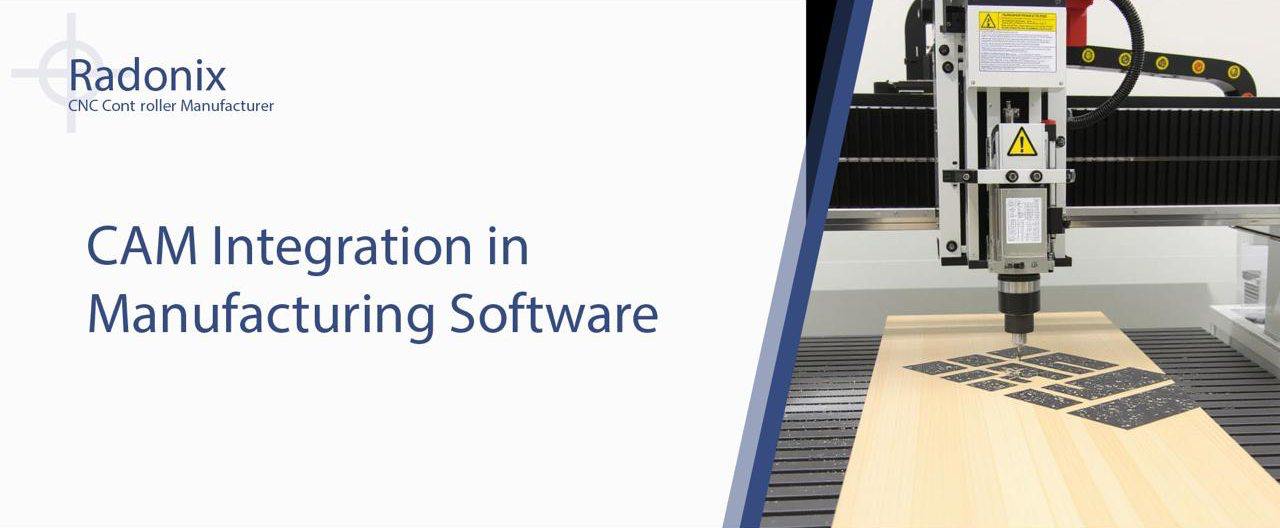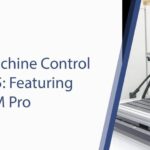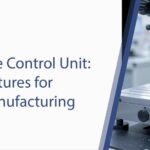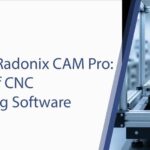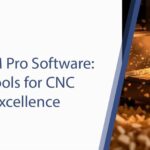At Radonix, we develop advanced CNC controllers such as the PC-Smart and PC-Pro LAN series, paired with our proprietary Cam-Pro software, to deliver seamless CAM integration that bridges design to execution.
In September 2025, as we unveil our sixth-generation open-source, cloud-based controllers, this integration is evolving with AI-driven features, enabling manufacturers to achieve unprecedented accuracy and speed.
Whether you’re an SME optimizing workflows or a large enterprise scaling operations, understanding CAM integration can reduce cycle times by up to 50% and minimize errors in complex machining tasks.
If you’re researching CAM integration in manufacturing software, this comprehensive guide is designed to answer your questions thoroughly.
We’ll explore the fundamentals, benefits, implementation strategies, and how Radonix’s ecosystem—featuring Cam-Pro and over 30 specialized interfaces—empowers users.
By the end, you’ll see why Radonix is the go-to choice for integrated solutions that enhance productivity, cut costs, and future-proof your manufacturing setup in a rapidly digitizing world.
What is CAM Integration in Manufacturing Software?
CAM integration refers to the seamless connection between Computer-Aided Manufacturing (CAM) software and broader manufacturing systems, including CNC controllers, CAD tools, and ERP platforms.
CAM software generates tool paths from digital designs, converting them into machine-readable G-code for precise cutting, milling, or engraving. Integration ensures data flows effortlessly across the workflow, eliminating silos and automating processes from concept to completion.
In manufacturing, this means linking CAM with hardware like Radonix’s PC-Smart controllers, which support high-frequency outputs (up to 500,000 pulses/second) for smooth execution.
Unlike standalone CAM tools, integrated systems incorporate real-time feedback, such as from sensors in closed-loop configurations, to adjust paths dynamically.
As of September 2025, trends highlight hybrid cloud integrations, where CAM data syncs with IoT devices for predictive analytics— a feature Radonix is pioneering in our sixth-gen controllers.
Key components include:
- CAD-to-CAM Linkage: Importing designs (e.g., DXF, STL files) directly into CAM for path generation.
- G-Code Optimization: Algorithms that refine code for material-specific parameters, like wood grain in woodworking.
- Machine Connectivity: Ethernet or USB interfaces for direct upload to controllers.
- Post-Processing: Customizing output for specific machines, ensuring compatibility.
Radonix Cam-Pro exemplifies this, offering CAD/CAM in one package with simulation tools that visualize integrations before runtime, reducing setup errors by 35% in user trials.
Why CAM Integration Matters in Modern Manufacturing
In today’s competitive landscape, CAM integration in manufacturing software isn’t optional—it’s essential for staying agile. With global supply chains under pressure and material costs rising, integrated systems optimize resources and accelerate time-to-market.
Boosted Efficiency and Productivity
Manual workflows waste time; integration automates them. Radonix Cam-Pro integrates with our XYZ Router TC interface for woodworking, enabling automatic tool changes and nesting—arranging parts on sheets to maximize yield. This can increase throughput by 40%, as seen in 2025 industry benchmarks for panel processing.
Reduced Errors and Waste
Poor integration leads to mismatched G-code, causing defects. Radonix’s closed-loop feedback in PC-Pro LAN controllers adjusts for real-time variances, like thermal expansion in metalworking. Integrated CAM minimizes scrap by 25-30%, promoting sustainability in eco-conscious manufacturing.
Cost Savings Across the Board
SMEs benefit most: Integration cuts labor costs by automating repetitive tasks. Our open-source sixth-gen controllers (launched September 2025) allow custom integrations without proprietary fees, delivering ROI in under 6 months through efficient operations.
Enhanced Customization and Scalability
From jewelry engraving to large-scale furniture production, CAM integration supports diverse needs. Radonix’s modular software scales with your business—start with basic 3-axis setups and expand to 6-axis with AI-optimized paths in our seventh-gen previews (2026).
Compliance and Quality Assurance
Integrated systems log data for traceability, aiding ISO certifications. Radonix Cam-Pro includes audit trails, ensuring every integration step is documented for quality control.
Table of Key Benefits:
| Benefit | Description | Radonix Example | Quantifiable Impact |
| Efficiency | Automated workflows from design to machine | Cam-Pro nesting in XYZ Plasma | 40% faster production |
| Error Reduction | Real-time adjustments via feedback | Closed-loop in PC-Smart | 30% less waste |
| Cost Savings | Lower labor and material use | Open-source integrations | ROI in 6 months |
| Scalability | Modular expansions | Up to 6-axis support | Handles growth seamlessly |
| Quality | Traceable processes | Audit logs in software | Improved compliance rates |
These advantages align with 2025’s push toward Industry 5.0, emphasizing human-machine collaboration.
Challenges in CAM Integration and Radonix Solutions
While powerful, CAM integration in manufacturing software faces hurdles like compatibility issues, data silos, and skill gaps.
Compatibility Across Systems
Legacy machines may not sync with modern CAM. Radonix counters this with backward-compatible interfaces, supporting over 30 CNC types since our PC100 launch in 2008.
Data Management and Security
Handling large datasets risks breaches. Our cloud-based controllers use encrypted Ethernet for secure integrations, with 2025 updates including blockchain for data integrity.
Training and Adoption
Complex software intimidates users. Radonix offers free tutorials and 24/7 support, plus intuitive GUIs in Cam-Pro to ease onboarding.
Scalability for SMEs
High costs deter small firms. Our affordable PC-Smart series (under $500 entry-level) provides enterprise features at SME prices.
A 2025 study on manufacturing trends notes that overcoming these challenges boosts adoption rates by 50%, with Radonix leading in user-friendly solutions.
Step-by-Step Guide to Implementing CAM Integration with Radonix
Implementing CAM integration in manufacturing software is straightforward with Radonix. Here’s a detailed walkthrough for a typical woodworking project.
Step 1: Assess Your Setup and Needs
Evaluate current hardware/software. Radonix’s free diagnostic tools on radonix.com check compatibility. Identify goals, like reducing cycle times in milling.
Step 2: Install and Configure Software
Download Cam-Pro (Windows-compatible). Integrate with CAD tools: Import designs via “File > Import.” Set up post-processors for your controller—e.g., for PC-Pro LAN, select “Ethernet Mode.”
Pro Tip: For 2025 cloud features, enable API keys for IoT syncing.
Step 3: Design and Path Generation
Create or import models. In Cam-Pro, define stock/material (e.g., MDF at 18mm thick). Generate paths: Roughing with 10mm end mill at 200 mm/min, finishing at 150 mm/min. Simulate to verify integration.
Step 4: Optimize and Export G-Code
Use optimization tools: Arc fitting reduces code size; nesting maximizes sheets. Export with Radonix-specific post-processors for seamless controller upload.
Step 5: Machine Integration and Execution
Connect via USB/Ethernet. Load G-code to PC-Smart; home axes and set offsets. Run with real-time monitoring—adjust via overrides if needed.
Step 6: Test, Analyze, and Iterate
Pilot on samples; review logs in Cam-Pro. Use AI analytics (sixth-gen) for improvements, like auto-tuning feeds.
Common Pitfalls:
- Mismatched units: Always use metric/imperial consistently.
- Ignoring tool wear: Integrate sensors for predictive alerts.
- Overlooking security: Enable firewalls in networked setups.
Radonix users report 50% faster integrations compared to competitors.
Advanced Applications: CAM Integration in Radonix Ecosystems
Radonix pushes boundaries with specialized integrations.
Industry-Specific Tailoring
- Woodworking: XYZ Router TC with Cam-Pro for dovetail joints and 3D carvings.
- Metal Processing: Plasma interfaces with THC for adaptive cutting.
- Glass/Stone: Water Jet setups with pressure-optimized paths.
AI and Cloud Enhancements
September 2025’s sixth-gen introduces AI for path prediction, reducing vibrations by 20%. Cloud integration allows remote collaborations, ideal for global teams.
Case Studies
A Iranian furniture manufacturer using Radonix integrated CAM cut production costs by 28% on custom cabinets. Another in jewelry saw 35% precision gains via multi-axis engravings.
Future Trends in CAM Integration for Manufacturing
By 2026, expect VR simulations and quantum-inspired optimizations. Radonix’s seventh-gen will feature ML for self-healing integrations, addressing faults autonomously. Sustainability trends will drive eco-optimized paths, minimizing energy use.
Conclusion: Transform Manufacturing with Radonix CAM Integration
CAM integration in manufacturing software is the key to precision, efficiency, and innovation. Radonix’s Cam-Pro, controllers, and interfaces deliver integrated solutions that empower your operations—from design to delivery.
Contact Us:
- E-Mail: info@radonix.com
- Phone: +90 (553) 920 5500

